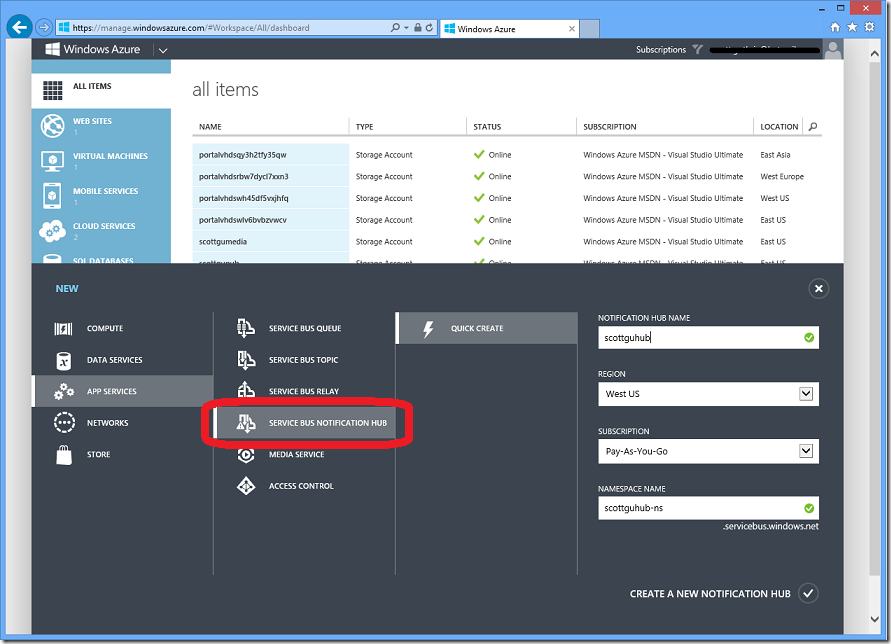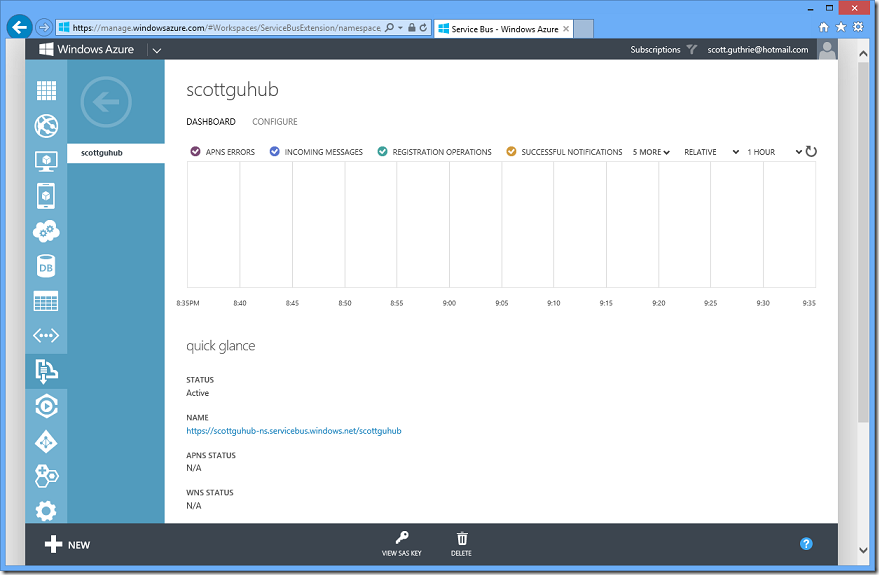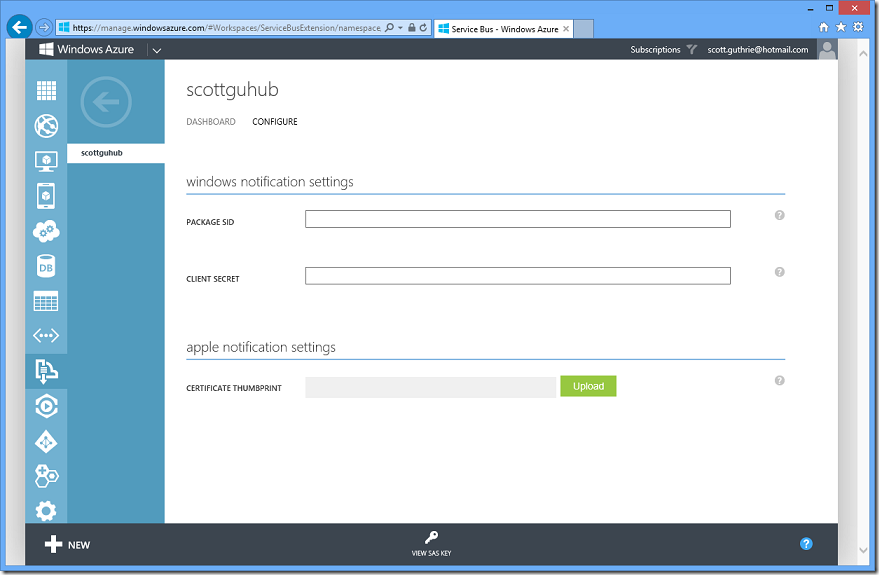Broadcast push notifications to millions of mobile devices using Windows Azure Notification Hubs
Today we released a number of great enhancements to Windows Azure.
I blogged earlier today about the general availability (GA) release of Windows Azure Media Services. Windows Azure Media Services provides everything you need to quickly build great, extremely scalable, end-to-end media solutions for streaming on-demand video to consumers on any device.
We also today released a preview of a really cool new Windows Azure capability – Notification Hubs. Notification Hubs provide an extremely scalable, cross-platform, push notification infrastructure that enables you to efficiently route push notification messages to millions of mobile users and devices.
Broadcast Push Notifications with Notification Hubs
Push notifications are a vital component of mobile applications. They are critical not only in consumer apps, where they are used to increase app engagement and usage, but also in enterprise apps where up to date information increases employee responsiveness to business events.
Sending a single push notification message to one mobile user is relatively straight forward (and is already incredibly easy to-do with Windows Azure Mobile Services). Efficiently routing push notification messages to thousands or millions of mobile users simultaneously is much harder – and the amount of code and maintenance necessary to build a highly scalable, multi-platform push infrastructure capable of doing this in a low-latency way can be considerable.
Notification Hubs are a new capability we are adding today to Windows Azure that provides you with an extremely scalable push notification infrastructure that helps you efficiently route push notification messages to users. It can scale automatically to target millions of mobile devices without you needing to re-architect your app or implement your own sharding scheme, and will support a pay-only-for-what-you-use billing model.
Today we are delivering a preview of the Notification Hubs service with the following capabilities:
- Cross-platform Push Notification Support. Notification Hubs provide a common API to send push notifications to multiple device platforms. Your app can send notifications in platform specific formats or in a platform-independent way. As of January 2013, Notification Hubs are able to push notifications to Windows 8 apps and iOS apps. Support for Android and Windows Phone will be added soon.
-
Efficient Pub/Sub Routing and Tag-based Multicast. Notification Hubs are optimized to enable push notification broadcast to thousands or millions of devices with low latency. Your server back-end can fire one message into a Notification Hub, and thousands/millions of push notifications can automatically be delivered to your users. Devices and apps can specify a number of per-user tags when registering with a Notification Hub. These tags do not need to be pre-provisioned or disposed, and provide a very easy way to send filtered notifications to an infinite number of users/devices with a single API call. Since tags can contain any app-specific string (e.g. user ids, favorite sports teams, stock symbols to track, location details, etc), their use effectively frees the app back-end from the burden of having to store and manage device handles or implement their own per-user notification routing information.
-
Extreme Scale. Notification Hubs enable you to reach millions of devices without you having to re-architect or shard your application. The pub/sub routing mechanism allows you to broadcast notifications in a super efficient way. This makes it incredibly easy to route and deliver notification messages to millions of users without having to build your own routing infrastructure.
- Usable from any Backend App. Notification Hubs can be easily integrated into any back-end server app. It will work seamlessly with apps built with Windows Azure Mobile Services. It can also be used by server apps hosted within IaaS Virtual Machines (either Windows or Linux), Cloud Services or Web-Sites. This makes it easy for you to take advantage of it immediately without having to change the rest of your backend app architecture.
Try Notification Hubs Today
You can try the new Notification Hub support in Windows Azure by creating a new Notification Hub within the Windows Azure Management Portal – you can create one by selecting the Service Bus Notification Hub item under the “App Services” category in the New dialog:
Creating a new Notification Hub takes less than a minute, and once created you can drill into it to see a dashboard view of activity with it. Among other things it allows you to see how many devices have been registered with it, how many messages have been pushed to it, how many messages have been successfully delivered via it, and how many have failed:
You can then click the “Configure” tab to register your Notification Hub with Microsoft’s Windows Notification System and Apple’s APNS service (we’ll add Android support in a future update):
Once this is setup, its simple to register any client app/device with a Notification Hub (optionally associating “tags” with them so that you can have the Notification Hub automatically filter for you who gets which messages). You can then broadcast messages to your users/mobile apps with only a few lines of code.
For example, below is some code that you could implement within your server back-end app to broadcast a message to all Windows 8 users registered with your Notification Hub:
var hubClient = NotificationHubClient.CreateClientFromConnectionString(connectionString, "scottguhub");
var notificationBody = WindowsNotificationXmlBuilder.CreateToastImageAndText04Xml("myImage.jpg", "text1", "text2", "text3");
hubClient.SendWindowsNativeNotification(notificationBody.InnerXml);
The single Send API call above could be used to send the message to a single user – or broadcast it to millions of them. The Notification Hub will automatically handle the pub/sub scale-out infrastructure necessary to scale your message to any number of registered device listeners in a low-latency way without you having to worry about implementing any of that scale-out logic yourself (nor block on this happening within your own code). This makes it incredibly easy to build even more engaging, real-time mobile applications.
Learn More
Below are some guides and tutorials that will help you quickly get started and try out the new Notification Hubs support:
- Fundamentals: Service Bus Notification Hubs
- Tutorial: Targeting Windows 8 Apps using Service Bus Notification Hubs
- Tutorial: Targeting iOS Apps using Service Bus Notification Hubs
I also highly recommend watching these two videos by Clemens Vasters:
Summary
Notification Hubs provide an extremely scalable, cross-platform, push notification infrastructure that enables you to efficiently route push notification messages to millions of mobile users and devices. It will make enabling your push notification logic significantly simpler and more scalable – and enable you to build even better apps with it.
You can try out the preview of the new Notification Hub support immediately. If you don’t already have a Windows Azure account, you can sign-up for a free trial and start using it today. We are looking forward to seeing what you build with it!
Hope this helps,
Scott
P.S. In addition to blogging, I am also now using Twitter for quick updates and to share links. Follow me at: twitter.com/scottgu


